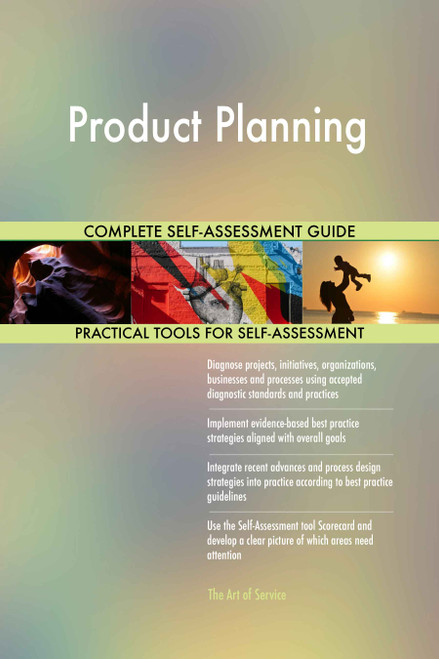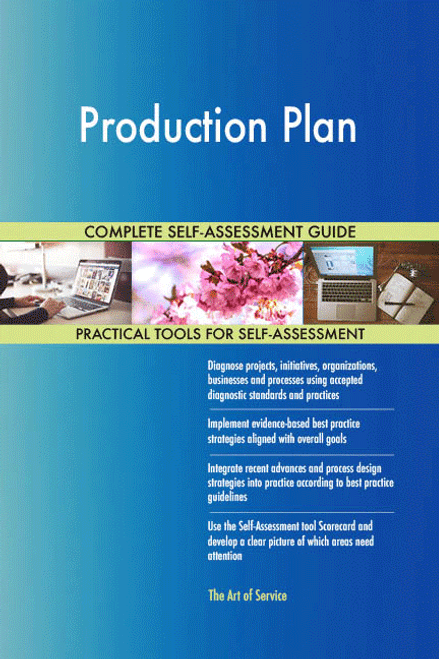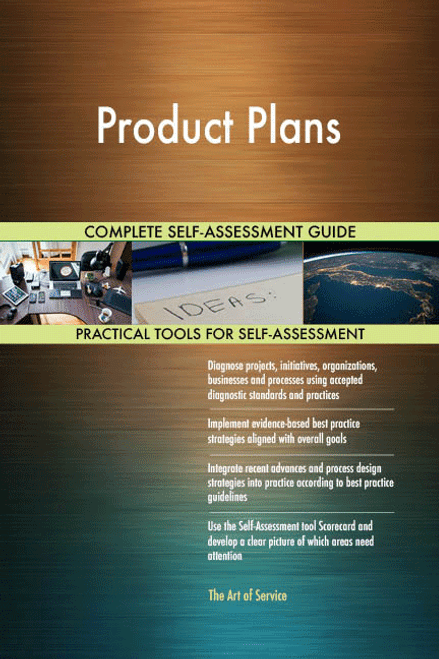Edge processing has developed into a full fledged technical revolution, and one of your goals as your organization is to help the industry achieve high performance and energy efficient computing through scalable, embedded processing.
More Uses of the Product Planning Toolkit:
- Arrange that your business tracks and reports on product launch metrics, utilizing feedback to drive associated actions and product iteration; contributes to post launch review and drive incorporation of feedback in future product releases.
- Manage work with the B2B leadership team to ensure a robust product vision and roadmap is set and adhered to across existing marketing solutions and new SaaS solutions for your hospitality customers.
- Manage knowledge and skills to execute a projects design intent from concept through final verification, working closely with the Industrial Design, Digital Modeling and Engineering Staff.
- Ensure assigned products are responsive to market needs, drive continuous improvements where needed to maintain and/or improve market penetration and share position.
- Analyze, interpret, and report out monthly management reports in regards to product sales activity to budget, programs, market and channel trends and competition.
- ExplorE Business opportunities and use cases for new and existing products based on deep customer understanding, Competitive Analysis, product market fit, and Product Differentiation.
- Establish that your business participates in the Product Planning process across a product group by overseeing the development of requirements documents (User Stories with acceptance criteria, use cases) for products or product releases.
- Ensure your operation analyzes market conditions and relevant competitors to determine appropriate timeline for Product Planning, Product Development, and launch of product.
- Run a robust communication process that helps stakeholder groups across your organization understand what is happening now, and what is happening in the future.
- Develop, plan and strategize to enhance current products and introduce new features to generate additional revenue and/or realize operational efficiencies.
- Drive a solution set across development and marketing teams through market requirements, user and Buyer Personas, Product Planning, and communication.
- Collect and synthesize information from customers, partners, competitors and internal organizations as engineering and Business Development teams as inputs to product concept development and Product Planning.
- Become skilled at defining and documenting business and functional requirements for ongoing system improvement initiatives in iterative Software Development environments.
- Ensure you revolutionize; build effective cross functional relationships with Product Marketing, sales, Account Management and engineering to drive execution and overall product success.
- Manage work with Product Managers, designers and business stakeholders to develop a strategic point of view of the needs of your customers and business to support planning of features.
- Arrange that your venture interacts internally and externally with executive level management, consultants and corporate leaders, requiring negotiation skills over extremely critical matters.
- Drive: monitor and assess Competitive Products and programs and as a result develop and implement proactive strategies to strengthen the product lines competitive edge.
- Use Market intelligence and Business Acumen to develop solid Market Equations to secure delivery of the plan at desired ROI with a long term view to growth and Customer Satisfaction.
- Confirm your design complies;
- Provide oversight and Project Management for New Product Introductions to keep marketing, organization and sales teams on track to launch milestones.
- Methodize: work closely with Product Planning and operations to support accurate forecasting, manage raw material complexity and deliver overall product line productivity.
- Coordinate with marketing and new product operations teams to set launch quantities of new product introductions and to ensure smooth product transitions.
- Initiate: plan, source and realize the production process on the respective production location in accordance with the target agreement, project target plan, timeline, quality targets, area, invest and production costs.
- Use Market Research, product research, product financial forecast, Product Testing, pricing and Competitive Analysis to develop products that are compelling to customers and consumers and on brand.
- Support Product Planning in conjunction with manufacturing and planning teams to deliver optimal Service Levels for products; analyze profitability and monitor key financial indicators.
- Guide: influence and partner with Market Research and new Product Planning to design qualitative and quantitative Market Research (either internal or external consultants).
- Ensure your corporation complies; directs Product Marketing managers in providing Field Marketing personnel with all the tools necessary to do a competent and professional job during the sales process.
- Confirm your team uses analytics to monitor product KPIs and ensure success metrics are being met; identifies opportunities for testing and product/product group enhancements based on result.
- Lead: for your marketing, sales and Product Management team, understanding the full potential of your technology and the trends in your markets is highly rewarding.
- Oversee full digital product life cycle stages through product inception, design, development, testing, implementation and validation of desired outcomes.
Save time, empower your teams and effectively upgrade your processes with access to this practical Product Planning Toolkit and guide. Address common challenges with best-practice templates, step-by-step Work Plans and maturity diagnostics for any Product Planning related project.
Download the Toolkit and in Three Steps you will be guided from idea to implementation results.
The Toolkit contains the following practical and powerful enablers with new and updated Product Planning specific requirements:
STEP 1: Get your bearings
Start with...
- The latest quick edition of the Product Planning Self Assessment book in PDF containing 49 requirements to perform a quickscan, get an overview and share with stakeholders.
Organized in a Data Driven improvement cycle RDMAICS (Recognize, Define, Measure, Analyze, Improve, Control and Sustain), check the…
- Example pre-filled Self-Assessment Excel Dashboard to get familiar with results generation
Then find your goals...
STEP 2: Set concrete goals, tasks, dates and numbers you can track
Featuring 999 new and updated case-based questions, organized into seven core areas of Process Design, this Self-Assessment will help you identify areas in which Product Planning improvements can be made.
Examples; 10 of the 999 standard requirements:
- How widespread is its use?
- How do you create buy-in?
- What harm might be caused?
- What are the potential basics of Product Planning fraud?
- How do you measure efficient delivery of Product Planning services?
- Who is gathering information?
- How do customers see your organization?
- What do people want to verify?
- Is there any other Product Planning solution?
- How is progress measured?
Complete the self assessment, on your own or with a team in a workshop setting. Use the workbook together with the self assessment requirements spreadsheet:
- The workbook is the latest in-depth complete edition of the Product Planning book in PDF containing 994 requirements, which criteria correspond to the criteria in...
Your Product Planning self-assessment dashboard which gives you your dynamically prioritized projects-ready tool and shows your organization exactly what to do next:
- The Self-Assessment Excel Dashboard; with the Product Planning Self-Assessment and Scorecard you will develop a clear picture of which Product Planning areas need attention, which requirements you should focus on and who will be responsible for them:
- Shows your organization instant insight in areas for improvement: Auto generates reports, radar chart for maturity assessment, insights per process and participant and bespoke, ready to use, RACI Matrix
- Gives you a professional Dashboard to guide and perform a thorough Product Planning Self-Assessment
- Is secure: Ensures offline Data Protection of your Self-Assessment results
- Dynamically prioritized projects-ready RACI Matrix shows your organization exactly what to do next:
STEP 3: Implement, Track, follow up and revise strategy
The outcomes of STEP 2, the self assessment, are the inputs for STEP 3; Start and manage Product Planning projects with the 62 implementation resources:
- 62 step-by-step Product Planning Project Management Form Templates covering over 1500 Product Planning project requirements and success criteria:
Examples; 10 of the check box criteria:
- Cost Management Plan: Eac -estimate at completion, what is the total job expected to cost?
- Activity Cost Estimates: In which phase of the Acquisition Process cycle does source qualifications reside?
- Project Scope Statement: Will all Product Planning project issues be unconditionally tracked through the Issue Resolution process?
- Closing Process Group: Did the Product Planning Project Team have enough people to execute the Product Planning project plan?
- Source Selection Criteria: What are the guidelines regarding award without considerations?
- Scope Management Plan: Are Corrective Actions taken when actual results are substantially different from detailed Product Planning project plan (variances)?
- Initiating Process Group: During which stage of Risk planning are risks prioritized based on probability and impact?
- Cost Management Plan: Is your organization certified as a supplier, wholesaler, regular dealer, or manufacturer of corresponding products/supplies?
- Procurement Audit: Was a formal review of tenders received undertaken?
- Activity Cost Estimates: What procedures are put in place regarding bidding and cost comparisons, if any?
Step-by-step and complete Product Planning Project Management Forms and Templates including check box criteria and templates.
1.0 Initiating Process Group:
- 1.1 Product Planning project Charter
- 1.2 Stakeholder Register
- 1.3 Stakeholder Analysis Matrix
2.0 Planning Process Group:
- 2.1 Product Planning Project Management Plan
- 2.2 Scope Management Plan
- 2.3 Requirements Management Plan
- 2.4 Requirements Documentation
- 2.5 Requirements Traceability Matrix
- 2.6 Product Planning project Scope Statement
- 2.7 Assumption and Constraint Log
- 2.8 Work Breakdown Structure
- 2.9 WBS Dictionary
- 2.10 Schedule Management Plan
- 2.11 Activity List
- 2.12 Activity Attributes
- 2.13 Milestone List
- 2.14 Network Diagram
- 2.15 Activity Resource Requirements
- 2.16 Resource Breakdown Structure
- 2.17 Activity Duration Estimates
- 2.18 Duration Estimating Worksheet
- 2.19 Product Planning project Schedule
- 2.20 Cost Management Plan
- 2.21 Activity Cost Estimates
- 2.22 Cost Estimating Worksheet
- 2.23 Cost Baseline
- 2.24 Quality Management Plan
- 2.25 Quality Metrics
- 2.26 Process Improvement Plan
- 2.27 Responsibility Assignment Matrix
- 2.28 Roles and Responsibilities
- 2.29 Human Resource Management Plan
- 2.30 Communications Management Plan
- 2.31 Risk Management Plan
- 2.32 Risk Register
- 2.33 Probability and Impact Assessment
- 2.34 Probability and Impact Matrix
- 2.35 Risk Data Sheet
- 2.36 Procurement Management Plan
- 2.37 Source Selection Criteria
- 2.38 Stakeholder Management Plan
- 2.39 Change Management Plan
3.0 Executing Process Group:
- 3.1 Team Member Status Report
- 3.2 Change Request
- 3.3 Change Log
- 3.4 Decision Log
- 3.5 Quality Audit
- 3.6 Team Directory
- 3.7 Team Operating Agreement
- 3.8 Team Performance Assessment
- 3.9 Team Member Performance Assessment
- 3.10 Issue Log
4.0 Monitoring and Controlling Process Group:
- 4.1 Product Planning project Performance Report
- 4.2 Variance Analysis
- 4.3 Earned Value Status
- 4.4 Risk Audit
- 4.5 Contractor Status Report
- 4.6 Formal Acceptance
5.0 Closing Process Group:
- 5.1 Procurement Audit
- 5.2 Contract Close-Out
- 5.3 Product Planning project or Phase Close-Out
- 5.4 Lessons Learned
Results
With this Three Step process you will have all the tools you need for any Product Planning project with this in-depth Product Planning Toolkit.
In using the Toolkit you will be better able to:
- Diagnose Product Planning projects, initiatives, organizations, businesses and processes using accepted diagnostic standards and practices
- Implement evidence-based Best Practice strategies aligned with overall goals
- Integrate recent advances in Product Planning and put Process Design strategies into practice according to Best Practice guidelines
Defining, designing, creating, and implementing a process to solve a business challenge or meet a business objective is the most valuable role; In EVERY company, organization and department.
Unless you are talking a one-time, single-use project within a business, there should be a process. Whether that process is managed and implemented by humans, AI, or a combination of the two, it needs to be designed by someone with a complex enough perspective to ask the right questions. Someone capable of asking the right questions and step back and say, 'What are we really trying to accomplish here? And is there a different way to look at it?'
This Toolkit empowers people to do just that - whether their title is entrepreneur, manager, consultant, (Vice-)President, CxO etc... - they are the people who rule the future. They are the person who asks the right questions to make Product Planning investments work better.
This Product Planning All-Inclusive Toolkit enables You to be that person.
Includes lifetime updates
Every self assessment comes with Lifetime Updates and Lifetime Free Updated Books. Lifetime Updates is an industry-first feature which allows you to receive verified self assessment updates, ensuring you always have the most accurate information at your fingertips.







